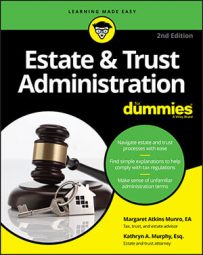Thinking about income taxes may not be high on your list of priorities as you begin administering an estate or trust, but it will soon become a main focus of your administration, whether you’re thrilled by the idea or not. Planning for those first income tax returns should begin right away, not at year-end when the first deadline for filing is fast approaching.
Obtain a federal tax ID number
Before you get started on any tax return, you need to know the federal Taxpayer Identification Number (or TIN), which will be either an Employer Identification Number (EIN) for estate and trust returns or the decedent’s Social Security number (SSN) for his or her final Form 1040.
Finding the decedent’s SSN is easy; it’s scattered all over his or her financial documents. The EIN, however, doesn’t exist until you apply for it. Apply for one as soon as you know you’re (a) going to have to open an estate bank account or investment account or (b) you’re going to have to file any sort of tax return for the estate (either income or estate).
Apply for the estate or trust’s TIN by using Form SS-4, Application for Employer Identification Number, which you can get by visiting any IRS office, phoning 800-829-4933, or going to IRS.gov.
When applying by phone or online, you receive your number immediately; you’ll receive a response to an application to the IRS service center for your state within four business days. If you file a physical application by mail, it takes up to ten days to receive the form from the IRS, and up to an additional four weeks to receive the number itself.
Every taxpayer needs a TIN, and you’re not allowed to file any tax returns without one that has been specifically assigned to that person, trust or estate. You can’t use the decedent’s SSN to file an estate return, nor can you use the estate’s EIN to file a return for a trust that inherits the estate’s property.
Still, obtaining a TIN only costs you a little time and no money, so don’t feel like you’re being wasteful because you’re not able to recycle ones that are no longer useful, like the decedent’s SSN. Be careful, though, and only apply for a TIN once for each taxpayer.
If you need to open even one bank or brokerage account for an estate, you have to apply for a TIN to do so. Applying alerts the IRS that a new trust or estate exists; it’s going to expect tax returns from that entity, even if there’s no obligation to file one.
Not to worry — if you receive a notice asking for a tax return, send the IRS a letter explaining that the estate didn’t have enough income to file. Or, to avoid the notice altogether, you can prepare and file a return showing no income.
If you need multiple EINs because you have multiple entities, take note: The days of applying for the estate’s EIN on the same day as you apply for the follow-up trust’s EIN are officially over. A new administrative rule limits the number of EINs you may apply for to one per day, no matter what method you use to apply (e-mail, fax, phone, or snail mail).
Choose a tax year-end
Although Congress created a general rule in 1986 that all individuals, businesses, and most trusts had to use December 31 as their tax year-end, every rule has exceptions. An estate may choose the last day of any month as its tax year-end, provided the first year doesn’t include more than 12 months.
Why choose a date other than December 31 as a tax year-end? Depending on how much income the estate stands to receive (and when), using a different year-end can substantially reduce the total income tax bite, especially if the estate’s administration will take more than 12 months from start to finish. If you haven’t already, create a schedule of when and how much income you expect the estate to receive.
Because estates and trusts reach the highest tax bracket very quickly, split the initial flow of income into two years, if possible. Whether the estate is paying the tax, or distributions to the beneficiaries mean that they’ll be responsible for the income tax bill, splitting income into two years can ease the overall income tax burden for both the estate and the heirs.
You’ll be asked to declare a year-end when applying for the trust or estate’s EIN, but your decision isn’t absolutely final until you file that first income tax return and put the year-end on the top of page 1.
If you choose a year-end other than December 31, you’re responsible for correctly accounting for all income received because the 1099s you receive from banks, brokerages, and others may not accurately reflect income for the tax year. Only your good recordkeeping will produce an accurate tax return.

